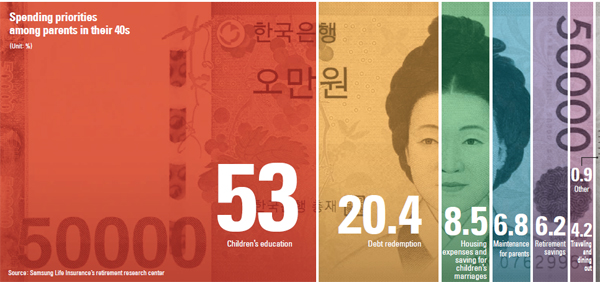Education costs hurting parents’ retirement plans

But Kim, a 48-year-old telecommunications company worker, says nearly half of that was put toward his eldest daughter’s private education expenses last year in preparation for the annual College Scholastic Ability Test (CSAT), the chief barometer here for college admission.
With their second child set to enter high school this month, the couple is assured they’ll be spending even more on hagwons, or private cram schools, in 2015.
“How can I resist the trend?” said Kim, who asked that his full name not be used. “This year, I have an additional financial load on my shoulders - my oldest daughter’s college tuition - so I doubt the hefty expenditure will go anywhere.”
Park Hyeon-mi, a mother of a high school senior who lives in Gangnam District, southern Seoul, had similar thoughts.
It’s common for parents who are salaried workers to “live on bankbooks in the red,” she said, because once their children enter high school, spending on private education soars exponentially.
“There are tons of moms out there who work part-time jobs to pay off their kids’ hagwon fees,” Park said. “Saving for retirement sounds too good to be true.”
In a recent survey led by the retirement research center under Samsung Life Insurance, respondents in their 40s and 50s chose their children’s education costs as the top priority in regard to household spending.
Of 2,300 adults questioned in Seoul and metropolises nationwide, 53 percent of the respondents in their 40s answered that those expenses mattered most. The majority was followed by debt redemption (20.4 percent), housing purchases and preparing for their child’s marriage (8.5 percent) and financial support for their parents (6.8 percent). Saving for retirement was prioritized by a mere 6.2 percent among respondents in their 40s.
For those in their 50s, roughly 37 percent said their children’s education was most crucial when planning out household spending, which also turned out to be the largest portion of expenses.
“It’s hard to get a job at a conglomerate these days, even after graduating from a top-tier university,” said Jeon Yeong-seon, a 47-year-old living in Seocho District, southern Seoul.
“I ‘invest’ in my child’s private education in the hopes that he will go on to study at a prominent school and get a highly paid, specialized job,” she added.
In Yongin, Gyeonggi, a 48-year-old who wished only to be identified by her surname Cho, said her son’s education is what prompted her to move out of the suburbs. While learning math and English from a personal tutor and covering Korean and social studies at a hagwon, the boy alone drains nearly 2 million won every month.
Private education fees for both her boys, the second of which is preparing for the 11th grade, cost around 3 million won per month.
“There was no way we could cover all that on just my husband’s monthly salary, so I started working, too,” Cho said. “We haven’t built our retirement nest egg yet. Our children come first.”
In today’s fast-aging Korean society, experts here argue that more parents are overspending on their children, so much so that they’re neglecting to save for their own wellbeing after retirement. And the long-held notion that getting their children into the most prestigious universities, which will in turn guarantee them coveted positions in the nation’s top conglomerates, has led many in their 40s and 50s to sacrifice financial steadiness.
“It’s not that parents are unaware of the fact that they are not saving up for retirement,” said Yoon Yoo-jin, a professor at Sungkyunkwan University and a member of the school’s Korea Private Education Research Center.
“But they see private education expenses as an inevitable form of investment, knowing that a decent occupation often guarantees higher salaries.”
However, Yoon Won-ah, a researcher at Samsung Life Insurance’s retirement research center, said it was “preposterous to sacrifice one’s own financial stability for a child’s private education.”
“[Our neighbor] Japan was no different not too long ago, but that’s changed recently. Koreans, too, must first build up retirement savings, and then think about educational expenses.”
Responding to a reporter’s question as to how much parents should spend on hagwons, Yoon said 20 to 30 percent of their total income, at most.
Kim Dong-yeob, the director of another retirement research center under Mirae Asset, also pointed out that parents in their 40s and 50s tended to overdo it on private academies simply because their child’s education was a present issue, unlike retirement, which can seem relatively far away.
He recommended that they examine their pensions.
“It’s really not that difficult to prepare for later when you sit down and calculate how much you’ll earn from your [retirement pension, personal pension and national pension], and then start drawing out budget plans from there,” Kim said.
BY SPECIAL REPORTING TEAM [selee@joongang.co.kr]










with the Korea JoongAng Daily
To write comments, please log in to one of the accounts.
Standards Board Policy (0/250자)